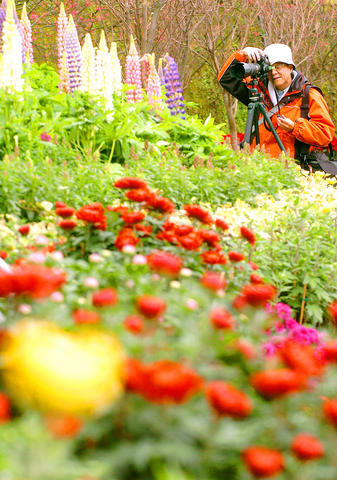Cherry trees bloomed on the winding road leading to Yangmingshan National Park at the start of the annual Yangmingshan Flower Festival in Taipei yesterday.
This year's festival, which runs through March 2, opened at various locations throughout the city.
In addition to more than 2,000 cherry trees in Yangmingshan National Park, the festival features azaleas, camellias, peach blossoms and hydrangeas, among other plants and flowers.

PHOTO: LIU HSIN-DE, TAIPEI TIMES
Teddy Kao (高道涵), spokesman for Taipei City's Parks and Street Lights Office, said about 50 percent of the flowers are in full blossom thanks to recent low temperatures, with more flowers expected to bloom during the Lunar New Year holidays.
At yesterday's opening ceremony, Taipei Mayor Hau Lung-bin (
He urged the public to take advantage of public transportation to avoid traffic jams around the park during the festival.
Kao suggested that visitors spend a day touring nearby attractions -- including the Lin Yu-tang House and the Shilin Presidential Residence, which is holding a rose show featuring various kinds of roses -- besides enjoying the flower festival.
Taipei City's Transportation Department said that, traffic control will be enforced along Yangde Boulevard. On weekends, a checkpoint will be established at Fuxing Bridge from 6am to 4pm to control vehicles entering the Yangmingshan area.
City-bound traffic will also be controlled at Lane 43 of Yangming Road, Section 1, from noon to 6 pm.
For traffic control information, call 02-2759-9741 and for bus route inquiries 0800-223-650.

LIMITS: While China increases military pressure on Taiwan and expands its use of cognitive warfare, it is unwilling to target tech supply chains, the report said US and Taiwan military officials have warned that the Chinese People’s Liberation Army (PLA) could implement a blockade within “a matter of hours” and need only “minimal conversion time” prior to an attack on Taiwan, a report released on Tuesday by the US Senate’s China Economic and Security Review Commission said. “While there is no indication that China is planning an imminent attack, the United States and its allies and partners can no longer assume that a Taiwan contingency is a distant possibility for which they would have ample time to prepare,” it said. The commission made the comments in its annual

DETERMINATION: Beijing’s actions toward Tokyo have drawn international attention, but would likely bolster regional coordination and defense networks, the report said Japanese Prime Minister Sanae Takaichi’s administration is likely to prioritize security reforms and deterrence in the face of recent “hybrid” threats from China, the National Security Bureau (NSB) said. The bureau made the assessment in a written report to the Legislative Yuan ahead of an oral report and questions-and-answers session at the legislature’s Foreign Affairs and National Defense Committee tomorrow. The key points of Japan’s security reforms would be to reinforce security cooperation with the US, including enhancing defense deployment in the first island chain, pushing forward the integrated command and operations of the Japan Self-Defense Forces and US Forces Japan, as

‘TROUBLEMAKER’: Most countries believe that it is China — rather than Taiwan — that is undermining regional peace and stability with its coercive tactics, the president said China should restrain itself and refrain from being a troublemaker that sabotages peace and stability in the Indo-Pacific region, President William Lai (賴清德) said yesterday. Lai made the remarks after China Coast Guard vessels sailed into disputed waters off the Senkaku Islands — known as the Diaoyutai Islands (釣魚台) in Taiwan — following a remark Japanese Prime Minister Sanae Takaichi made regarding Taiwan. Takaichi during a parliamentary session on Nov. 7 said that a “Taiwan contingency” involving a Chinese naval blockade could qualify as a “survival-threatening situation” for Japan, and trigger Tokyo’s deployment of its military for defense. Asked about the escalating tensions

The Ministry of Economic Affairs said it plans to revise the export control list for strategic high-tech products by adding 18 items under three categories — advanced 3D printing equipment, advanced semiconductor equipment and quantum computers — which would require local manufacturers to obtain licenses for their export. The ministry’s announcement yesterday came as the International Trade Administration issued a 60-day preview period for planned revisions to the Export Control List for Dual Use Items and Technology (軍商兩用貨品及技術出口管制清單) and the Common Military List (一般軍用貨品清單), which fall under regulations governing export destinations for strategic high-tech commodities and specific strategic high-tech commodities. The